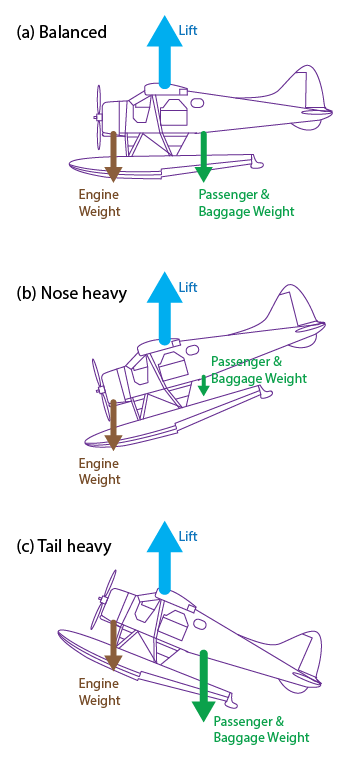
Viewed from the side, an aircraft acts like a seesaw (teeter totter). The wings provide lift, which holds the whole aircraft up. The engine (on the fuselage) is in front of the point of lift, so gravity tends to tilt the nose (the front) of the aircraft down. Depending on the location of the aircraft seats, some of the passengers might be sitting behind the point of lift, so gravity force on the passengers tends to tilt the tail (the back) of the aircraft down (tilting the nose up like a teeter totter). Thus, the distribution of weight in the aircraft relative to the lift point determines the balance of the aircraft (see Fig. a).
But aircraft are almost never perfectly balanced, because you might want to carry diffferent numbers of passengers or baggage or fuel for different flights. So to compensate, you (the pilot) can move the control yoke (steering wheel) forward and back, which tilts the elevator up or down at the back of the aircraft, to cause aerodynamic forces on the back end of the aircraft to tilt the tail down or up. This allows you to control the aircraft to climb (nose high, tail low), descend (nose low, tail high), or fly level. Sweet.
But the elevator can tilt only so far, depending on how the aircraft was designed. So it can compensate for only some maximum amount of inbalance. The amount of imbalance that is allowed depends on the aircraft. Luckily, you have a Pilots Operating Handbook or Flight Manual (instruction manual) that helps you figure out if your aircraft balance is within the allowed limits.
You should always check the weight and balance before take-off. If the plane is too heavy to fly, then you could reduce the weight by carrying fewer passengers, less fuel, or less baggage. If the plane is out of balance, then you can move people and baggage to different seats in the aircraft to get the aircraft into balance before they take off. If you cannot get the aircraft to be within the allowed weight and balance limits, then the regulations stay that you are not allowed to make that flight.
What happens if you try to fly when the aircraft is not within the required weight and balance limits.
- If
the plane is too heavily loaded, then you will be unable to take off.
(You might be able to get a meter or two above the ground due to
a phenomenon called "ground effect", but you could not climb any
higher.)
- If the nose is too heavy (figure b), then the aircraft
flies nicely on a diagonal path downward until it crashes on the
ground. Full elevator movement by the pilot is insufficient to
counteract the nose-heavy tilt of the airplane. (For this
situation, it is unlikely that the aircraft could even take off.)
- If the tail is too heavy, then full elevator movement is insufficient to compensate for the imbalance. So the tail tilts down and the nose of the aircraft rises. But as the nose rises, the aircraft trys to climb upward against the pull of gravity, and thus the aircraft speed slows. If the aircraft gets too slow, then there is not enough air going over the wings to keep the aircraft flying. So the wings stall, and the aircraft falls out of the sky and crashes on the ground. If you are turning left or right while this happens, then the aircraft can stall even sooner (i.e., at faster airspeed, due to the extra g-forces associated with the turn).